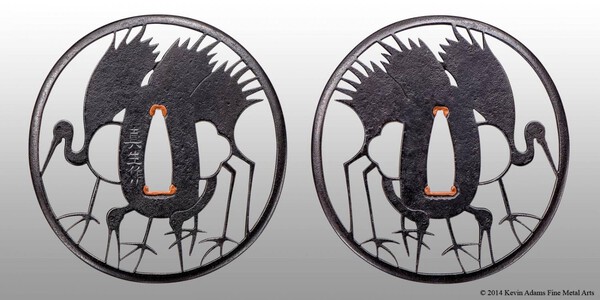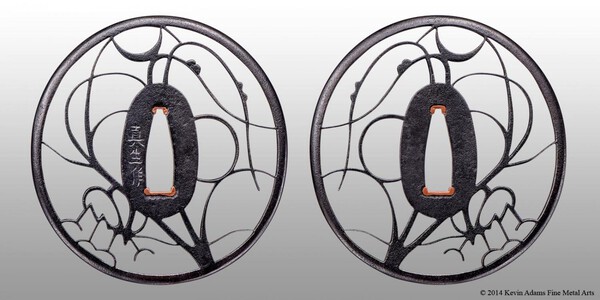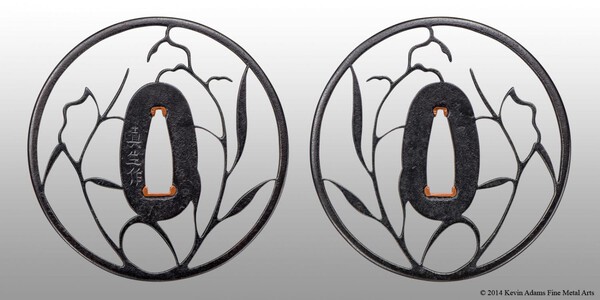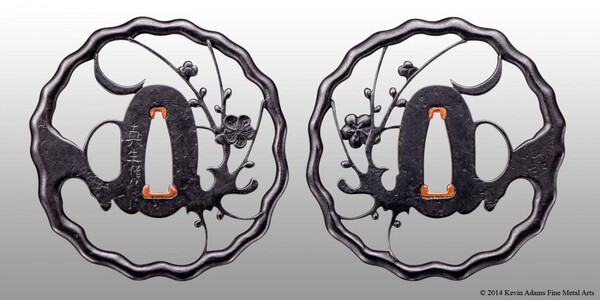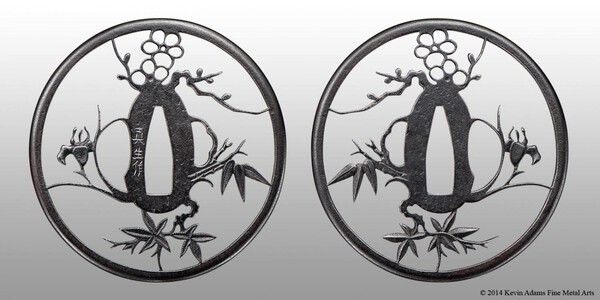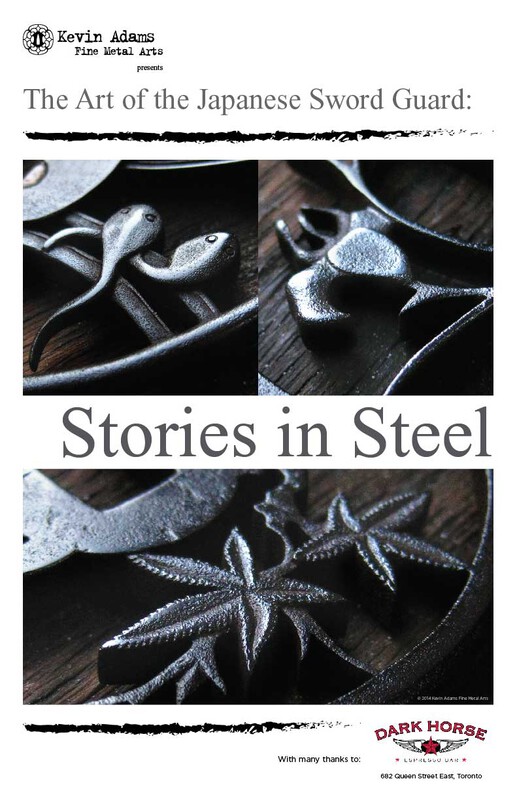-
Posts
257 -
Joined
-
Last visited
-
Days Won
5
Content Type
Profiles
Forums
Events
Store
Downloads
Gallery
Everything posted by Kevin Adams
-
What a lovely thing to say, thank you so much Grev! Four Seasons tsuba is now sold.
-
I think this might be Jurojin, he is often shown with a deer in artworks. I don't know about the mei, but the carving is very clumsily done. The pine tree is hastily executed, and the facial features are contorted. The nunome-zogan is basic at best (have a look at the cross-hatched chisel marks around the deer, they really shouldn't be visible). But what really bothers me is the textured strip that surrounds the man's head and continues down the body - it doesn't seem to represent anything, why is it there? Frankly, this is amateurish work - look also at the ryo hitsu, and how it interferes with the design of the man. I think someone recently took an existing tsuba and carved on it, rather than it being a considered piece of work from the beginning.
-
I just arrived in Torquay for a period of working with Ford, and the wine rack is already starting to look a bit empty. So I'm thinking I should tempt you all a bit more on these tsuba in order to sufficiently replenish our supply. $750USD + shipping and PayPal fees gets you any one of these pieces. Pretty good, right? I'll also entertain reasonable offers on multiple tsuba, just shoot me a message. I have the pine tree and four seasons tsuba with me here in the UK and can ship them immediately - otherwise, I have to send orders out on the 12th once I'm back in Toronto. Support some artists!
-
Just bumping this one back up to the top. These are still for sale, but I'll be in the UK (Torquay) from Sunday until March 11th, so if you're interested we can make a deal but won't be able to ship until I get back. UNLESS, of course, you live in the UK and you get in touch today or tomorrow. I can always bring a piece with me that you're interested in, and can post from there...
-
I can't help but wonder if a question asked elsewhere in the Tosogu forum needs to be reworded slightly and asked here: What are the objective criteria we currently use to evaluate pre-edo kinko tsuba, regardless of whether we "like" the particular piece under review? Because if there's a concern about "fakery", shouldn't we reexamine what we "know" about the work in question? Especially since that knowledge seems to have been rather effectively challenged...
-
Back to the top...
-
Thanks gents! Bob, I'll be in Torquay from the 1st to the 11th - I could always bring that one with me...
-
I'm combining my previous sale threads into one, to make things a bit easier. I had done this on the previous iteration of the forum, but it seems to have disappeared. Moderators, please delete my previous sale threads for these pieces. I'm planning a trip to the UK in March to work with Ford on a new project, so am motivated to sell these pieces towards that end. I've knocked a bit more off the prices for the rest of February, but don't hesitate to get in touch with a reasonable offer. Let's make a deal! Some more photos and discussion can be found in this thread, and some larger photos can be found on my Flickr feed. 1. Akasaka "3 Cranes" tsuba. This is an utsushi of a well-known Akasaka tsuba. The crane, or “tsuru”, is a treasured symbol of longevity and good fortune due to its mythical lifespan of 1000 years. It is also a symbol of fidelity since the birds mate for life, and is a common motif throughout all Japanese art forms. Steel plate with copper sekigane, includes a custom-fitted kiribako. 81mm x 84mm. $1000USD $900USD + shipping & Paypal fees, if applicable. 2. Akasaka "Bell Cricket, Moon and Grasses" tsuba. This is an copy of an Akasaka tsuba. A cricket chirps one last song as the summer gives way to autumn, and the grass begins to wilt under a crescent moon. Popularly depicted in poetry and art, this scene is closely associated with seasonal change and is a recurring theme in the haiku of Buson and Issa. Steel plate with copper sekigane, includes a custom-fitted kiribako. 79mm x 84mm. $1000USD $900USD + shipping & Paypal fees, if applicable. 3. Akasaka "Seasonal Grasses" tsuba. This is an copy of an Akasaka tsuba. There probably is no more universal representation of the natural world than grass. Stretching across vast fields, small tufts barely surviving on mountainsides, strands wilting in droughts - there is no stronger and more subtle way to depict the harmony, harshness or subtle motions of nature. Steel plate with copper sekigane, includes a custom-fitted kiribako. 80mm x 81mm. $1000USD $900USD + shipping & Paypal fees, if applicable. 4. Higo "Plum Blossom" tsuba. This is a study of a well-known Hayashi tsuba. As one of the first blossoms to open during the year, the plum blossom, or “ume”, is firmly associated with seasonal change, namely the start of spring. As such it is also a symbol of unyielding endurance, having overcome the cold winter to give spring its fragrance. Steel plate with copper sekigane, includes a custom-fitted kiribako. 80mm x 82mm. $1350USD $1250USD + shipping & Paypal fees, if applicable. 5. Akasaka "Four Seasons" tsuba. This is a study of an Akasaka tsuba in the Sasano collection. It was a particularly interesting one for me, in that the motif isn't QUITE the Four Gentlemen. The replacement of the chrysanthemum with maple leaves makes me wonder what the artist had in mind, although it, in my opinion, still stands as a clear motif of the four seasons. I've also deliberately pushed the carving further than one might see on Akasaka work, because there was a wonderful opportunity to do so. This is one of my favourites in the collection, and was very satisfying to make. Steel plate, includes a custom-fitted kiribako. 79mm x 81mm. $1350USD $1250USD + shipping & Paypal fees, if applicable. 6. Akasaka "Pine Trees" tsuba. This is a copy of an Akasaka tsuba in the Sasano collection. Studying pine trees and their portrayal in Japanese art is an ongoing project of mine, and this tsuba is the first piece to come from that study. It is a very strong-feeling piece, in spite of it being about a millimetre thinner than the original. Again, I've pushed the carving on the needles further than on the original - there was a chance to explore them further than linework in kebori, so these needle clusters are more reminiscent of later work outside of the Akasaka school. This, along with the Four Seasons tsuba above, is one of my favourites in the collection. Steel plate with copper sekigane, includes a custom-fitted kiribako. 81mm x 85mm. $1350USD $1250USD + shipping & Paypal fees, if applicable.
-

Tsuba presentation at J.C.C.C. Token Kai by Kevin Adams
Kevin Adams replied to b.hennick's topic in Tosogu
Thanks James, I appreciate it! -

Tsuba presentation at J.C.C.C. Token Kai by Kevin Adams
Kevin Adams replied to b.hennick's topic in Tosogu
Thank you Christian, you're very kind. :D -

Tsuba presentation at J.C.C.C. Token Kai by Kevin Adams
Kevin Adams replied to b.hennick's topic in Tosogu
I just wanted to let everyone know that the owners of the gallery space have graciously allowed me to keep the show up until the end of November. If you haven't had a chance to make it down yet, you have a bit more time. Please come by, support an artist and a local business! Also, I'd like to remind you all that these tsuba are for sale (listings in the Classifieds). Christmas is coming, you should treat yourself! -
Am I missing an additional set of photos? I don't see any other menuki provided for comparison, maybe it's something on my end. I think the best "evidence" for this discussion is well- and evenly-lit macro photography of the underside of these menuki. If we can find the elusive "line" along the tail that shows how the metal is pushed together in the uchidashi technique, we should have our answer. EDIT: Sorry David, I just went back in the discussion and noticed that you found it. Any chance you can capture it in a photo? Frankly though, I think there is enough structure present to confirm this as-is, and these are certainly better-made than typical repro menuki. As always though, it's a challenge to make assertions like with only photographs on the internet and no in-hand examination.
-
I look forward to reading your rationale.
-
I feel a shinsaku tadpole koshirae coming on... Thank you for the additional views of the menuki and those koshirae photos, guys! The F/K is quite charming and reminds me of trying to catch those groups of tadpoles as a kid.
-

Tsuba presentation at J.C.C.C. Token Kai by Kevin Adams
Kevin Adams replied to b.hennick's topic in Tosogu
Thanks folks! -
Love 'em. After doing Ford's uchidashi class last week I'm considering doing something along these lines... May we see the underside?
-

Tsuba presentation at J.C.C.C. Token Kai by Kevin Adams
Kevin Adams replied to b.hennick's topic in Tosogu
The tsuba shots are great! I look like hell! Sounds about right, since I had finished the group just the day before. Thanks for the kind words, everyone, it's been a long and challenging 4.5 months of work. The reason for making these pieces was to hold a small exhibition of my work in a local gallery space. I was very interested (still am, actually) in trying to bring the aesthetic peculiarities of tsuba to a wider audience, and to this end selected what I consider to be some of the more recognizable motifs in Akasaka work (with some Higo and Shoami thrown into the mix, just for fun). By keeping the motifs recognizable and "accessible", cultural idiosyncrasy becomes less of a barrier, and the work becomes more like a painting or a photograph, especially when framed and stuck on a wall. A "lay" viewer is then armed with knowledge of context (sword guard) and subject matter, allowing a more full and open appreciation of the work through contemplation of composition and technique. The show has only been up since Monday and I've already had some wonderful chats with complete strangers who aren't "swordy-types" about the work. These aren't really "utsushi" though, at least not in the complete sense that I consider to be the proper definition. I haven't gone to the effort of studying the iron used in the extant examples, I was more interested in studying the execution of the piercing and carving. While these are based on published examples, I have deviated a bit on a few, where I thought it would be interesting to do so. For example, the Four Seasons tsuba is published in the Sasano Gold Book, but the detail work is exclusively kebori. There was a wonderful opportunity to push the carved details further than might be seen on Akasaka work. Same with the Pine Tree tsuba - the carving on the needles is more typical of later work than on the published example. Again, an opportunity to push the motif a bit further. But some, like the 3 Cranes tsuba, is a faithful reproduction of the original reference. I didn't see the need to "push" it. Arnold, I hope this answers your question. Once the furor dies down a bit and my new website goes live I'll make a sale posting for these pieces, as they are for sale. A lot happening at the moment, these are interesting times! Thanks again. -
As I alluded to in this topic a while ago... viewtopic.php?f=2&t=20284 ____________________________________________ The Art of the Japanese Sword Guard ~ Stories in Steel Oct. 27 - Nov. 15th, 2014 - Dark Horse Espresso Bar (682 Queen St. East, Toronto) From my Facebook page (bear with me on the language, it's aimed at non-swordy types... ) "After much teasing and allusion via social media, I'd like to invite you all to a little something I've been working on... As many of you know, a few years ago I embarked on the path of Classical Japanese metalworking, and that this has manifested itself for the most part as fittings for Japanese swords. While this has its own cultural niche and context that I study constantly, I've lately been attempting to refine the way in which I talk to people about this kind of work. Making the jump in perception from "cultural artifact" to "legitimate art form" is a story that I'm very interested in telling, and I've drawn inspiration to this end not only from my teacher Ford Hallam, but from other metalworkers circling this tradition and from an emerging group of individuals attempting to resurrect oral storytelling traditions. There is an inextricable link between processes that were passed down from teacher to student, and how those processes were used to create the work. It is absolutely not just a causal matter of "do A to achieve B". It is instead a winding, organic process that serves only to develop an artist's sensitivity to the interplay between tool, material, subject matter, and their perceptions about the work. This narrative is what creates meaning in the work, and allows it to become what it was meant to be, and more. So let me tell you a story, in a way that you may not have heard before. Allow me to show you a Japanese sword guard (tsuba) that is more than a centerpiece ornament for a sword, but a miniature depiction of the natural world, as perceived by a human being, using tools and processes that are reflective of that human being's immersion in a narrative. Let me show you some of my work that represents a chapter marker. Let me tell you a bit of my story. Please swing by Dark Horse Espresso Bar (682 Queen Street East, Toronto), grab yourself a coffee, and immerse yourself in a story 400+ years in the making. I might even see you there, and we'll have some chats." Here's a temporary online gallery with some photos of the tsuba that will be on display (and also for sale). Be sure to check back every now and again, I'll be updating it with additional photos as the display is put up in addition to the ura sides. Hope to meet some of you there!
-
Same here. I've often wondered what physical data there is to back up the "ring test", since it seems prevalent not just in dialogue about sword fittings but in general metallurgical practice...
-
That entire koshirae is so sumptuous and gorgeous, but for some reason I keep coming back to the shots of the kojiri. There is just something about it that intrigues and makes me want to study it under magnification... Thank you so much for sharing these photos!
-
Doug, I didn't mean to come across as having a go at you, I just think we all need to be careful about making assumptions. I was genuinely curious why you thought the way you did, if a little direct in the asking. Steve, far from it. I have a great teacher. Junichi - interesting point about the relief work in sanmei tsuba being mistaken for a casting. I seem to recall a few discussions about that here. Clearly some searching and reading is in order this evening.
-
This is a curious notion - what led you to conclude that earlier pieces might have been cast? To my understanding, chiseling has been integral to the Japanese metalworking tradition almost from the beginning, it didn't just appear as a replacement for something else. Evidence of using punches to create textures and move metal is also present, ranging from early examples into the present day. You wouldn't always see marks on chisel work, so no. That's a very bold assumption. Consider the size of the inlays on tosogu - it would be a far more efficient use of time (as well as demonstrating greater sensitivity to the work) to simply cut out the piece needed, inlaying it, and carving it. Creating a model, creating a mould, casting, inlaying and refining the shape is a lot of unnecessary steps for the same (arguably inferior) result. Yes, although there is some speculation that early sukashi work was carved out with a chisel rather than pierced. I remember a few discussions here about it, but can't find them at the moment. Buy lots of books (Grey can help you with that), look at lots of pieces (Philly will be good for that) and ask lots of questions.



